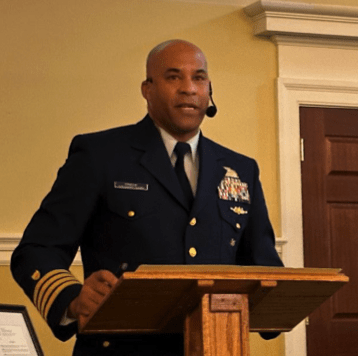By David Michonski

At the Retired Men’s Association (RMA) meeting on January 18th, Gerry Gibian of the RMA introduced as the speaker of the day, Captain Michael Fredie, the U.S. Coast Guard Academy director of admissions, who spoke about the U.S. Coast Guard and its role today and in U.S. history and gave examples of what the Coast Guard does in the U.S. and around the world today.
The Coast Guard’s motto is “Semper Paratus” translated as “Always Ready.” Founded in 1790, the Coast Guard’s creation was urged by Alexander Hamilton when he was secretary of the treasury. Secretary Hamilton wanted vessels on the high seas to be a “sentinel of the laws” and be certain to collect taxes at the entrance of U.S. ports. Thus, the Coast Guard started as a revenue marine service and then it became a lighthouse service.
The Coast Guard remained under the Department of Treasury until 1967, when it was moved to the Department of Transportation. In 2003 it was moved again to the U.S. Department of Homeland Security. Not being under the Department of Defense gives it special powers because it is exempt from the federal law that prohibits using the military for law enforcement. The Coast Guard can and does enforce laws. Thus, its job is to “Secure the Homeland.” By law, i.e., 14 USC 1032, its job is to “maintain a state of readiness to assist in the defense of the United States.” To do this it has 60 multi and bilateral agreements to enter into the sovereign waters of foreign nations.
The Coast Guard covers 95,000 miles of coastline, 360 seaports, 3,700 marine terminals and 25,000 miles of waterways. It has 41,600 active-duty members, 7,000 reserves, 8,200 civilians (staff, professionals, et al) and 26,000 auxiliary (volunteers who put on a uniform). This is very small work force for a huge mission. Plus, it has 1,700 “boats” which are those under 65 feet. Those over 65 feet are called “cutters.” It currently has 251 cutters, with icebreakers, patrol boats, small harbor tugs, seagoing buoy tenders, and the large National Security Cutter class that can land a helicopter on it, as well as its training ship, the tall-ship called the “Barque Eagle,” a 295-foot cutter. Its ice breakers can break ice near the poles and river buoy tenders help to keep rivers navigable. It also has 220 aircraft, from fixed wing aircraft to rotary-wing aircraft.
The 11 statutory missions that the Coast Guard performs every day follow:
1. Search and Rescue. In 2022 it saved 4,747 lives, assisted 21,000 people in distress, conducted 16,402 “search and rescue” cases, worked in 21 named storms during the Atlantic hurricane season, and saved $61 million of property.
2. Drug Interdiction. In 2022 USCG prevented 381,399 pounds of cocaine and 71,392 pounds of marijuana (with an estimated street value of $7.2 billion) from entering the U.S. while intercepting 635 suspected smugglers.
3. Migrant Interdiction. In FY 2022, it intercepted 13,357 undocumented migrants trying to illegally enter the United States by sea vs. 2,365 in 2021, and 467 in 2020. Thus far in FY 2023 there have been 4,795 interceptions (to compare apples to apples) putting it enroute to about 19,000 interceptions, the largest on record. Captain Fredie said these are largely caused by unstable governments in the Central American and Caribbean region.
4. General Law Enforcement. In FY 2022 the USCG intercepted 169 illegal incursions by foreign fishing vessels into the U.S. waters. It boarded 57 foreign vessels to suppress illegal unreported and unregulated fishing on the high seas.
5. Living Marine Resources. Yearly the USCG boards U.S fishing vessels annually to issue significant fisheries violations and enforce fishery laws.
6. Ports, Waterways and Coast Security. In 2022 the USCG conducted 65,000 patrols of maritime critical infrastructure, escorted 562 high-capacity passenger vessels, conducted 1,733 boardings of high investment vessels (large vessels) and completed 3,065 boardings of small vessels.
7. Defense Readiness. Six patrol boats and an advanced interdiction team support the U.S. Central Command in Bahrain which conducted 9,000 waterside and 12,000 other searches.
8. Aids to navigation. USCG maintains 46,00 buoys and beacons around the U.S.
9. Marine Safety. Inspected 15,000 containers for structural and hazardous material compliance. Conducted 18,000 inspections of U.S. flagged vessel. Performed 5,000 inspections of foreign vessels.
10. Marine Environmental Protection. Responded to over 11,000 pollution incidents and deployments of the National Strike Force to support natural disasters.
11. Ice Operations. Performed nearly 5,000 hours of icebreaking to keep waterways open and enabled 14 million tons of product to safely move through ice impeded U.S. waters. It also deployed its icebreakers to Antarctica and currently tracks 169 icebergs in the North Atlantic.
SEMPER PARATUS: The Coast Guard is always ready.
The entire presentation with all of its detail is available at https://greenwichrma.org/, click on “Speakers.”
The RMA’s next presentation, “Cable News and How It Changed the American Landscape” will focus on and assess the influence of cable news in the world today. Come hear David Fitzpatrick, a former staff writer for CNN’s Anderson Cooper 360, describe the transition from the time when news came directly from its original source with little or no embellishment to today’s mix of news and opinion. David was a CNN anchor producer, senior executive producer and investigative producer from 2001-2021. David is a graduate of Brigham Young University and is a 35 year plus resident of Darien,
This presentation will occur on Wednesday, February 1, at 11:00 a.m. at the First Presbyterian Church in Greenwich as well as on webinar at: https://bit.ly/30lBj21.
Note: The views expressed in these RMA presentations are those of the speakers. They are not intended to represent the views of the RMA or its members.
RMA speaker presentations are presented as a community service at no cost to in-person or Zoom attendees, regardless of gender. The RMA does request that all eligible individuals consider becoming a member of our great organization, and thereby enjoy all the available fellowship, volunteer and community service opportunities that the RMA offers to its members. For further information, visit https://greenwichrma.org or contact Joe Mancinelli (mailto:jlmanc@optonline.net) or Peter Stern (mailto:members@greenwichrma.org).





